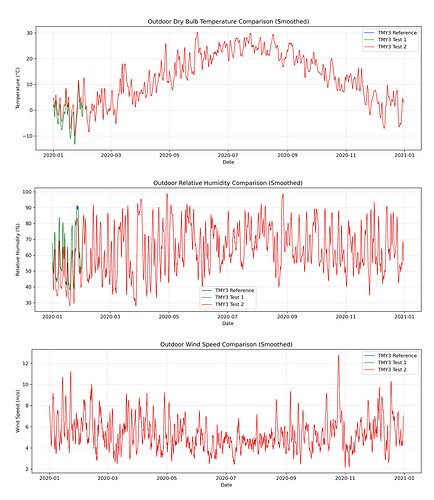Dear Ladybug Tools community,
I wanted to kindly reach out here to ask for some technical guidance with my implementation of the Urban Weather Generator tool, which I see is now managed by Ladybug Tools.
The problem is that while this tool runs, I find that the tool is not picking up variation in windspeed, along with some other key weather file outputs.
Because I struggle with grasping the Grasshopper environment, I chose to implement the Urban Weather Generator tool using the pure python script from this GitHub repository, which I see is managed by Ladybug Tools:
To demonstrate the issue I am encountering with the UWG tool, I tried to take a base case reference TMY3 EPW file for New York City – Central Park and use UWG to modify the ‘bldheight’, ‘blddensity’, ‘vertohor’, ‘grasscover’, and ‘treecover’ parameters. I tried to modify these parameters in two “extreme” test cases where I create a heavily developed test case to be compared with a much less developed test case, to compare how the output microclimate-adjusted EPW would be influenced, with the expectation that I would see significant variation in my weather file outputs of interest: outdoor drybulb temperature, outdoor relative humidity, and windspeed.
Here is how I am implementing the code, first starting with my “very green microclimate” (Test 1):
from uwg import UWG
# Define the .epw, .uwg paths to create an uwg object.
epw_path = r"C:/Users/MyName/Downloads/USA_NY_New.York-Central.Park.725033_TMY3.epw"
new_epw_name = r"C:/Users/MyName/Downloads/USA_NY_New.York-Central.Park.725033_TMY3_test1.epw"
# Initialize the UWG model by passing parameters as arguments, or relying on defaults
model = UWG.from_param_args(epw_path=epw_path, new_epw_name=new_epw_name, bldheight=3, blddensity=0.05,
vertohor=0.08, grasscover=0.65, treecover=0.30, zone='4A')
model.generate()
model.simulate()
# Write the simulation result to a file.
model.write_epw()
I then create the microclimate-adjusted EPW file for my “extremely developed microclimate” (Test 2):
new_epw_name = r"C:/Users/MyName/Downloads/USA_NY_New.York-Central.Park.725033_TMY3_test2.epw"
# Initialize the UWG model by passing parameters as arguments, or relying on defaults
model = UWG.from_param_args(epw_path=epw_path, new_epw_name=new_epw_name, bldheight=50, blddensity=0.91,
vertohor=3.5, grasscover=0.05, treecover=0.03, zone='4A')
model.generate()
model.simulate()
# Write the simulation result to a file.
model.write_epw()
The code runs, but when I open the output microclimate-adjusted weather files (.epw) and plot the time series data, I see that while the UWG tool noticeably captured variation in outdoor temperature and relative humidity, there is no variation at all in windspeed between both test cases. I show these results with the following plots, comparing EPW files:
For comparing outdoor dry bulb temperature (°C), outdoor relative humidity (%), and wind speed (m/s):
I checked the EPW data itself, comparing between the reference base case EPW, the Test 1 EPW, and the Test 2 EPW, and can confirm that the wind speed values at each timestamp between both microclimate-adjusted weather files are indeed exactly the same, and not just very close in value. Simply trying to compare exact averages of outdoor temperature, outdoor humidity, and wind speed between each EPW file, I received the following, confirming my concern:
Precise averages for each EPW file (RAW DATA):
Label Avg_Temp_C Avg_RH_pct Avg_WS_mps
0 TMY3 Reference 12.4817465753 64.8559360731 5.3554337900
1 TMY3 Test 1 12.4834703196 64.8500000000 5.3556621005
2 TMY3 Test 2 12.7162899543 63.9538127854 5.3556621005
We see that wind speed between the reference EPW and the UWG adjusted EPWs is different, even if only by a microscopic difference, but wind speed from Test 1 and Test 2 is exactly the same.
Could someone in this community please help me understand if I am implementing the UWG tool correctly, or if perhaps my own understanding of how the UWG tool works to adjust weather files is incorrect? Or was the outcome I received actually expected? Or could this perhaps be a bug with the tool?
My research investigation goal here is to understand the degree to which the urban heat island effect can influence building HVAC use, and from the looks of these results, my guess is that the UHI effect would not be very significant at all, which seems to go against all I have read about the impact of the UHI effect on building space conditioning loads and energy consumption. I was surprised to find the development and vegetation parameters to have such a small impact on the weather file adjustments.
I would appreciate any guidance on this technical issue, thank you very much!
Lino
